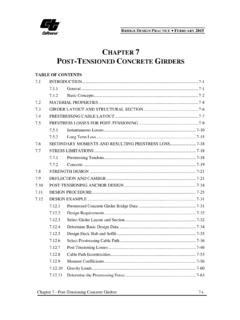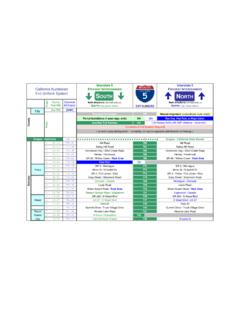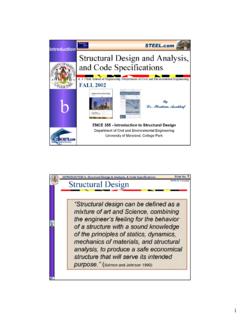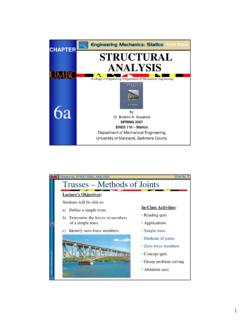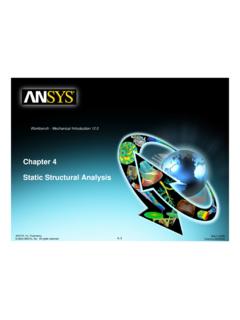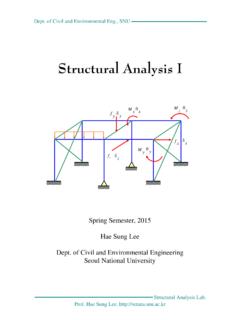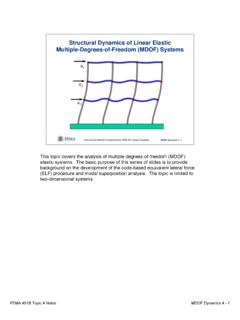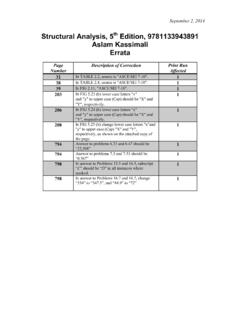Transcription of CHAPTER 4 - STRUCTURAL MODELING AND ANALYSIS
1 BRIDGE DESIGN PRACTICE FEBRUARY 2015 CHAPTER 4 STRUCTURAL MODELING and ANALYSIS 4-i CHAPTER 4 STRUCTURAL MODELING AND ANALYSIS TABLE OF CONTENTS INTRODUCTION .. 4- 1 STRUCTURE MODELING .. 4- 1 General .. 4- 1 STRUCTURAL MODELING Guidelines .. 4- 5 Material MODELING Guidelines .. 4- 7 Types of Bridge Models .. 4- 7 Slab-Beam Bridges .. 4- 9 Abutments .. 4- 15 Foundation .. 4- 16 Examples .. 4- 18 STRUCTURAL ANALYSIS .. 4- 27 General .. 4- 27 ANALYSIS Methods .. 4- 28 BRIDGE EXAMPLES 3-D VEHICLE LIVE LOAD ANALYSIS .. 4- 36 Background .. 4- 36 Moving Load Cases .. 4- 37 Live Load Distribution For One And Two-Cell Box Girders Example .. 4- 40 NOTATION .. 4- 53 REFERENCES .. 4- 54 BRIDGE DESIGN PRACTICE FEBRUARY 2015 CHAPTER 4 STRUCTURAL MODELING and ANALYSIS 4-ii This page is intentionally left blank.
2 BRIDGE DESIGN PRACTICE FEBRUARY 2015 CHAPTER 4 STRUCTURAL MODELING and ANALYSIS 4-1 CHAPTER 4 STRUCTURAL MODELING AND ANALYSIS INTRODUCTION STRUCTURAL ANALYSIS is a process to analyze a STRUCTURAL system to predict its responses and behaviors by using physical laws and mathematical equations. The main objective of STRUCTURAL ANALYSIS is to determine internal forces, stresses and deformations of structures under various load effects. STRUCTURAL MODELING is a tool to establish three mathematical models, including (1) a STRUCTURAL model consisting of three basic components: STRUCTURAL members or components, joints (nodes, connecting edges or surfaces), and boundary conditions (supports and foundations); (2) a material model; and (3) a load model.
3 This CHAPTER summarizes the guidelines and principles for STRUCTURAL ANALYSIS and MODELING used for bridge structures. STRUCTURE MODELING General For designing a new structure, connection details and support conditions shall be made as close to the computational models as possible. For an existing structure evaluation, structures shall be modeled as close to the actual as-built STRUCTURAL conditions as possible. The correct choice of MODELING and ANALYSIS tools/methods depends on: a) Importance of the structure b) Purpose of STRUCTURAL ANALYSIS c) Required level of response accuracy This section will present MODELING guidelines and techniques for bridge structures. Types of Elements Different types of elements may be used in bridge models to obtain characteristic responses of a structure system. Elements can be categorized based on their principal STRUCTURAL actions.
4 A) Truss Element A truss element is a two-force member that is subjected to axial loads either tension or compression. The only degree of freedom for a truss (bar) element is axial displacement at each node. The cross sectional dimensions and material properties of each element are usually assumed constant along its length. The element may interconnect in a two-dimensional (2-D) or three- BRIDGE DESIGN PRACTICE FEBRUARY 2015 CHAPTER 4 STRUCTURAL MODELING and ANALYSIS 4-2 dimensional (3-D) configuration. Truss elements are typically used in ANALYSIS of truss structures. b) Beam Element A beam element is a slender member subject to lateral loads and moments. In general, it has six degrees of freedom at each node including translations and rotations.
5 A beam element under pure bending has only four degrees of freedom. c) Frame Element A frame element is a slender member subject to lateral loads, axial loads and moments. It is seen to possess the properties of both truss and beam elements and also called a beam-column element. A three-dimensional frame formulation includes the effects of biaxial bending, torsion, axial deformation, and biaxial shear deformations. A frame element is modeled as a straight line connecting two joints. Each element has its own local coordinate system for defining section properties and loads. d) Plate Element A plate element is a two dimensional solid element that acts like a flat plate. There are two out-of-plane rotations and the normal displacement as Degree of Freedom (DOF). These elements model plate-bending behavior in two dimensions.
6 The element can model the two normal moments and the cross moment in the plane of the element. The plate element is a special case of a shell element without membrane loadings. e) Shell Element A shell element (Figure ) is a three-dimensional solid element (one dimension is very small compared with another two dimensions) that carries plate bending, shear and membrane loadings. A shell element may have either a quadrilateral shape or a triangular shape. Shell element internal forces are reported at the element mid-surface in force per unit length and are reported both at the top and bottom of the element in force per unit area. It is primarily used to determine local stress levels in cellular superstructure or in cellular pier and caissons. It is generally recommended to use the full behavior unless the entire structure is planar and is adequately restrained.
7 BRIDGE DESIGN PRACTICE FEBRUARY 2015 CHAPTER 4 STRUCTURAL MODELING and ANALYSIS 4-3 Figure Shell and Solid Elements f) Plane Element The plane element is a two-dimensional solid, with translational degrees of freedom, capable of supporting forces but not moments. One can use either plane stress elements or plane strain elements. Plane stress element is used to model thin plate that is free to move in the direction normal to the plane of the plate. Plane strain element is used to model a thin cut section of a very long solid structure, such as walls. Plain strain element is not allowed to move in the normal direction of the element s plane. g) Solid Element A solid element is an eight-node element as shown in Figure for MODELING three-dimensional structures and solids.
8 It is based upon an isoparametric formulation that includes nine optional incompatible bending modes. Solid elements are used in evaluation of principal stress states in joint regions or complex geometries (CSI, 2014). h) The NlLink Element A NlLink element (CSI, 2014) is an element with STRUCTURAL nonlinearities. A NlLink element may be either a one-joint grounded spring or a two-joint link and is assumed to be composed of six separate springs, one for each degree of deformational degrees of freedom including axial, shear, torsion, and pure bending. Non-linear behavior is exhibited during nonlinear time-history analyses or nonlinear static analyses. Types of Boundary Elements Selecting the proper boundary condition has an important role in STRUCTURAL ANALYSIS . Effective MODELING of support conditions at bearings and expansion joints requires a careful consideration of continuity of each translational and rotational component of displacement.
9 For a static ANALYSIS , it is common to use a simpler assumption of supports ( fixed, pinned, roller) without considering the soil/ foundation system stiffness. However for dynamic ANALYSIS , representing the soil/foundation stiffness is essential. In most cases choosing a [6 6] stiffness matrix is adequate. BRIDGE DESIGN PRACTICE FEBRUARY 2015 CHAPTER 4 STRUCTURAL MODELING and ANALYSIS 4-4 For specific projects, the nonlinear MODELING of the system can be achieved by using nonlinear spring/damper. Some Finite Element programs such as ADINA (ADINA, 2014) have more capability for MODELING the boundary conditions than others. Types of Materials Different types of materials are used for bridge structure members such as concrete, steel, prestressing tendons, etc.
10 For concrete structures, see Article and for steel structures see Article of the AASHTO LRFD Bridge Design Specifications (AASHTO, 2012). The material properties that are usually used for an elastic ANALYSIS are: modulus of elasticity, shear modulus, Poisson s ratio, the coefficient of thermal expansion, the mass density and the weight density. One should pay attention to the units used for material properties. Types of Loads There are two types of loads in a bridge design: Permanent Loads: Loads and forces that are assumed to be either constant upon completion of construction or varying only over a long time interval (AASHTO ). Such loads include the self weight of structure elements, wearing surface, curbs, parapets and railings, utilities, locked-in force, secondary forces from post-tensioning, force effect due to shrinkage and due to creep, and pressure from earth retainments (CA ).


